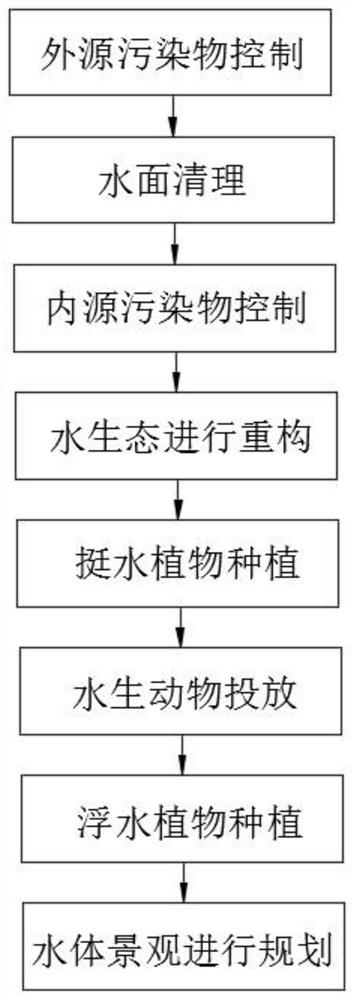Water body ecological restoration method
A technology for ecological restoration and water body, applied in chemical instruments and methods, botanical equipment and methods, water/sewage treatment, etc., can solve the problems of harsh original environment, micro-ecological destruction, and increased quantity
- Summary
- Abstract
- Description
- Claims
- Application Information
AI Technical Summary
Problems solved by technology
Method used
Image
Examples
Embodiment 1
[0036] When the water body is out of balance, exogenous pollutants should be controlled first, and the sewage should be intercepted and treated by building storage dams in the river; the floating objects on the water surface should be collected and cleaned, so that the depth of light transmission at the bottom of the water can reach 1-1.5m. A 10x10cm mesh cotton net with a depth of 0.8-1.2m is placed at the water inlet; for the control of internal pollutants, combined with the actual situation of the silt environment on site, a dredging disposal plan is formulated, environmental dredging projects are carried out, and silt disposal and reuse are carried out; submerged plants are planted: Take a non-woven fabric to make small square holes with a diameter of 4-6cm, and mix 7 submerged plants of hornwort, foxtail algae, bamboo leaf eye vegetable, black algae, weed, bitter grass and waterwheel at a ratio of 1:1. The ratio of 1:1:1:1:1 is inserted into the small hole of the non-woven...
Embodiment 2
[0038] In embodiment one, add following operation:
[0039] In step 1, the control of exogenous pollutants includes sewage interception and treatment projects. A large amount of domestic sewage is directly discharged into the water body without effective treatment, causing a large amount of pollutants to pollute the target water body. In order to achieve long-term effective water quality control goals, the Directly discharge sewage around the surrounding area for sewage interception, build storage dams in the river, design and build rubber dams and fishing net fences, which can effectively store water, ensure the continuous flow of the river in all seasons, meet the flood discharge function of the river, and use it to grow aquatic economic crops and farm fish Shrimp, turn sewage into resources.
[0040] When the water body is out of balance, exogenous pollutants should be controlled first, and the sewage should be intercepted and treated by building storage dams in the river; ...
Embodiment 3
[0042] In embodiment two, add following operation:
[0043] In step 3, mechanical dredging removes most of the black and smelly bottom sludge, and the remaining black and smelly bottom sludge is controlled by biological dredging. The beneficial microbial system on the mud surface consumes organic matter, nitrogen, phosphorus and other pollutants in the bottom mud through the metabolism, division and proliferation of microorganisms, so it can effectively control the release of pollutants in the black and odorous bottom mud. Combined with the actual situation of the silt environment on site, formulate a dredging disposal plan, carry out environmental dredging projects, silt disposal and reuse; the design of the bottom improvement project needs to improve the bottom of the river before the construction of the water ecosystem to meet the requirements of submerged water. Planting requirements, promote the formation of a healthy and stable water ecosystem as soon as possible; the nu...
PUM
| Property | Measurement | Unit |
|---|---|---|
| thickness | aaaaa | aaaaa |
| thickness | aaaaa | aaaaa |
Abstract
Description
Claims
Application Information
 Login to View More
Login to View More - R&D
- Intellectual Property
- Life Sciences
- Materials
- Tech Scout
- Unparalleled Data Quality
- Higher Quality Content
- 60% Fewer Hallucinations
Browse by: Latest US Patents, China's latest patents, Technical Efficacy Thesaurus, Application Domain, Technology Topic, Popular Technical Reports.
© 2025 PatSnap. All rights reserved.Legal|Privacy policy|Modern Slavery Act Transparency Statement|Sitemap|About US| Contact US: help@patsnap.com

